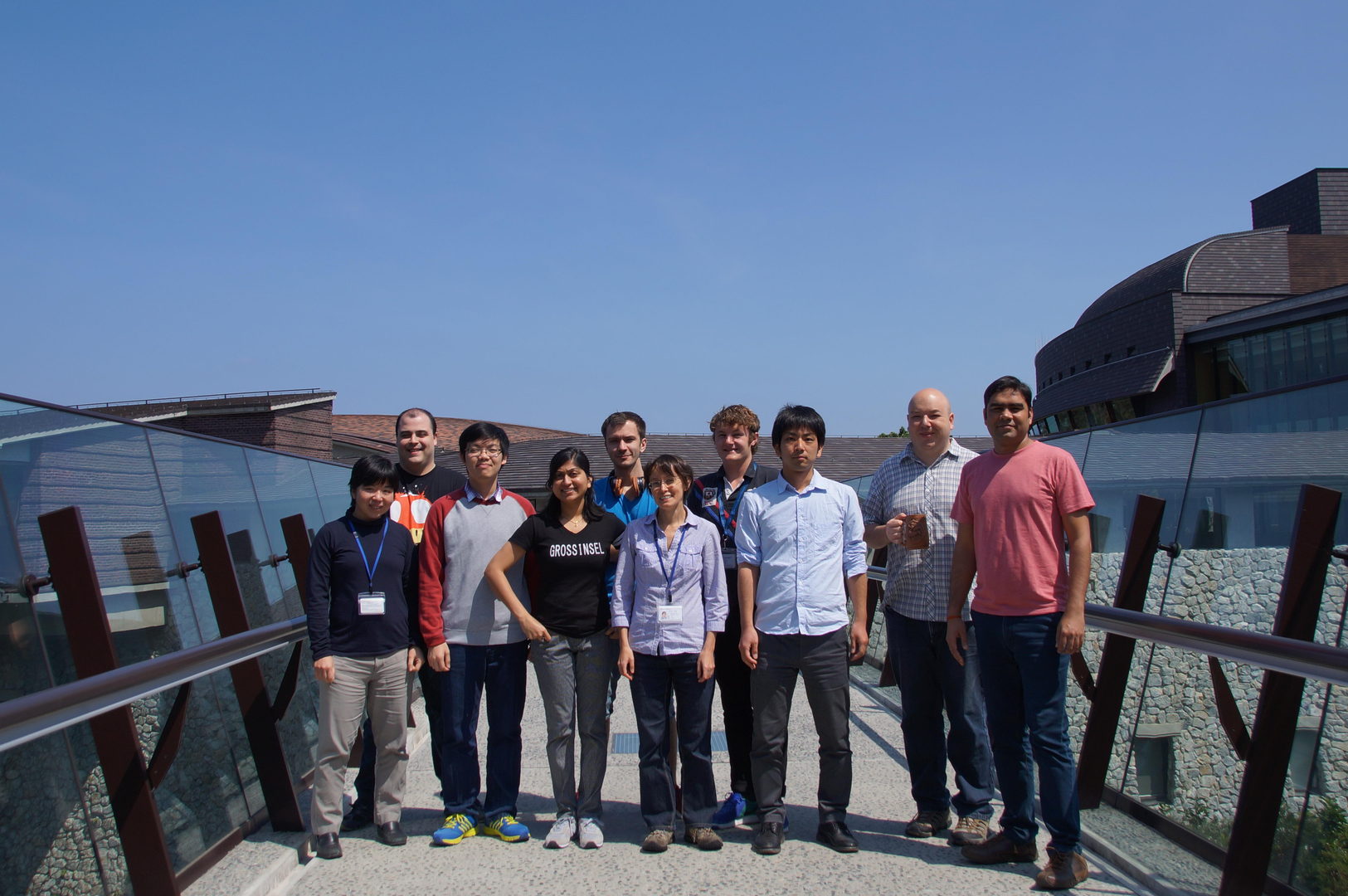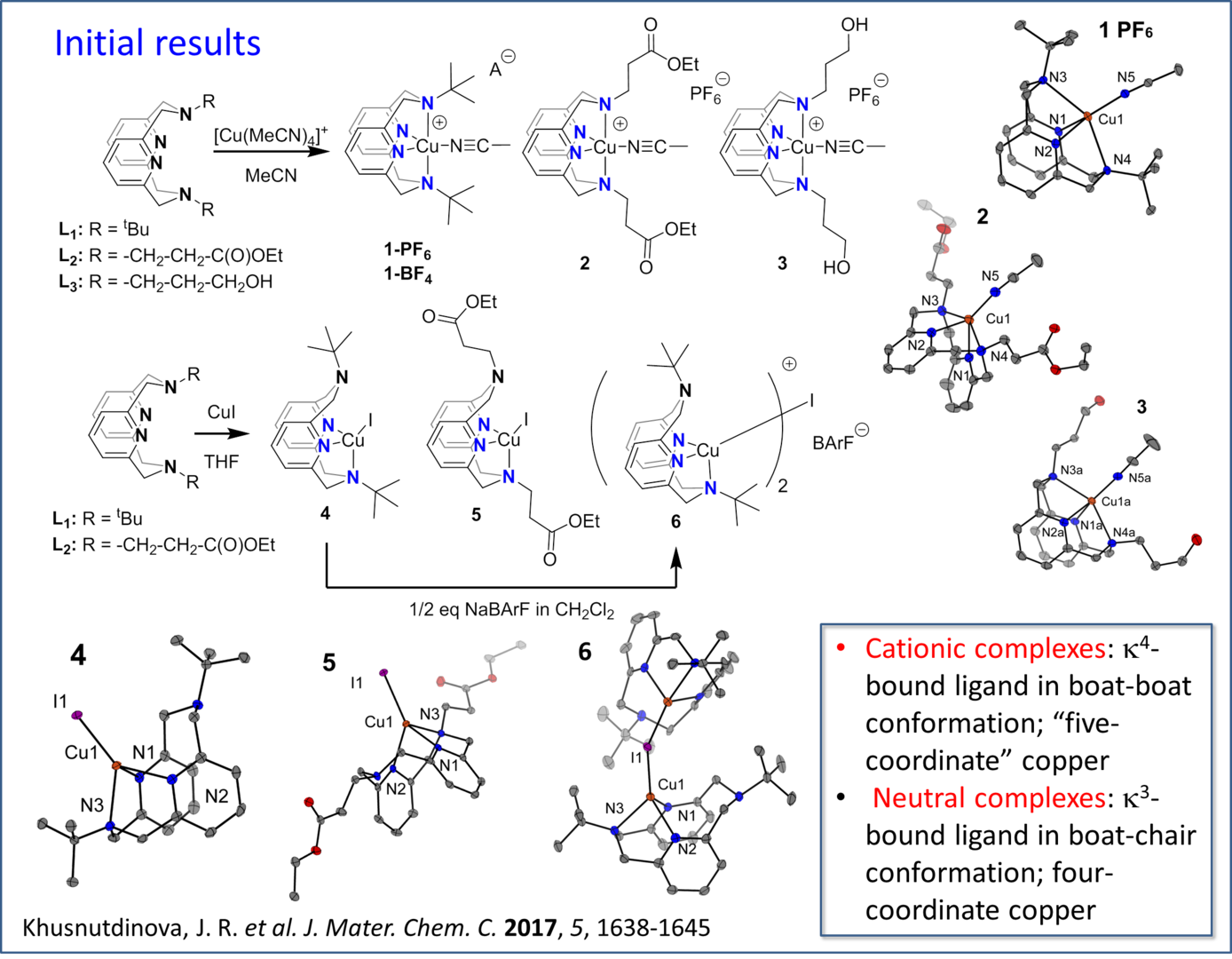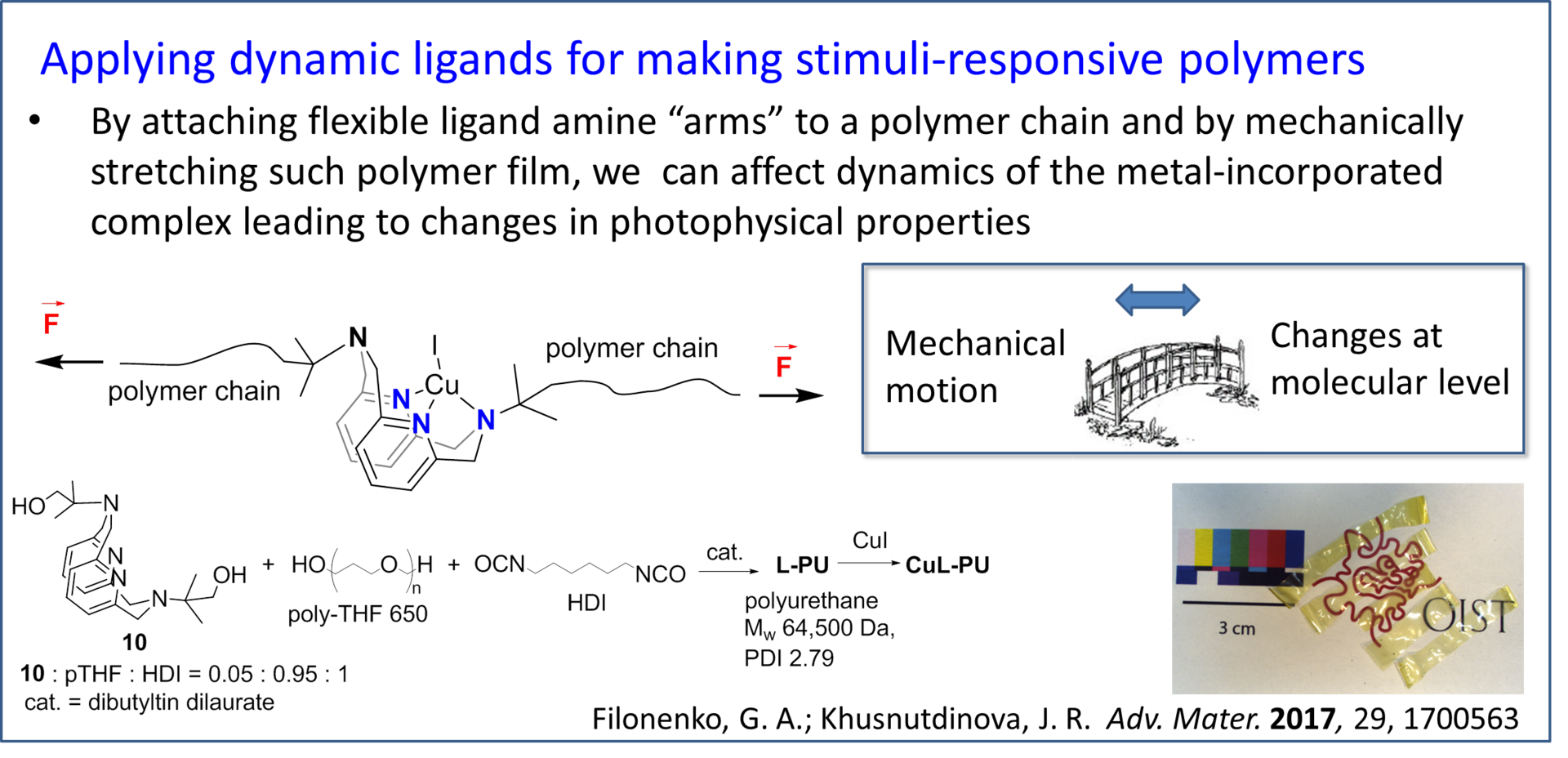FY2016 Annual Report
Coordination Chemistry and Catalysis Unit
Assistant Professor Julia Khusnutdinova

Abstract
During FY2016, our group has been focusing on studying photoluminescent metal complexes and their application to create stimuli-responsive polymers. The idea developed in our group is to utilize dynamic and flexible metal complexes as mechanoresponsive probes. In 2016, we demonstrated the first practical application of our approach in mechanoresponsive polymer design.
We discovered a new class of photoluminescent Cu(I) complexes supported by a simple N-donor macrocyclic ligand, N4 pyridinophane. This complexes show tunable luminescence that can be easily controlled by the ligand design. As these complexes are based on an inexpensive metal and easily accessible, non-phosphine ligand, they show promise in development of new luminescent materials.
Furthermore, we utilized similar copper complexes to create unique polymer material that shows fast and reversible response to mechanical stress. The material design is based on the novel concept developed in our group to use conformationally flexible ligands to observe fine changes in response to mechanical stress.
We also started the project on CO2 reduction to useful organic products catalyzed by an earth-abundant and cheap metal, manganese that we will continue to study in FY2017.
1. Staff
- Dr. Abhishek Dubey, Postdoctoral Scholar
- Dr. Orestes Rivada Wheelaghan, JSPS Research Fellow
- Dr. Georgy Filonenko, Postdoctoral Scholar
- Dr. Pradnya Patil, Postdoctoral Scholar
- Sebastien Lapointe, Graduate Student
- Luca Nencini, Research Intern
- Shubham Deolka, Research Intern
- Sandra Lucia Aristizabal Guerrero, Research Intern
- Minh Hoan Dinh, Research Intern
- Tanner Jankins, Research Intern
- Kyoko Chinen, Research Unit Administrator
2. Collaborations
2.1 CO2 Reduction Catalyzed by Earth-Abundant Metal Complexes
- Description: Utilization of manganese complexes with proton-responsive ligands for reduction of CO2 to value-added products.
- Type of collaboration: Joint research
- Researchers:
- Professor Carlo Nervi, University of Turin, Italy
- Mr. Luca Nencini, University of Turin, Italy
3. Activities and Findings
3.1 Tunable photoluminescent Cu(I) complexes based on N-donor macrocyclic N4 ligand
We have developed a new type of photoluminescent Cu(I) complexes supported by a simple N-donor ligand, N’,N’’-dialkyl-2,11-diaza[3.3](2,6)pyridinophane (RN4), that show emission in the solid state and in solution. The N4 ligand provides a convenient platform to create well-defined, solution stable Cu(I) complexes that show easily tunable photophysical properties that can be controlled by the complex charge and nature of the substituent at the axial amine door. In complexes 1-6 (Scheme 1), emission maximum varies in the 0.5 eV range and quantum yield ranges from 0.02 to 0.78.

Figure 1: Synthesis and X-ray structures of pyridinophane Cu(I) complexes.

Figure 2: Photophysical properties of pyridinophane Cu(I) complexes.
The intriguing feature of pyridinophane ligand is its conformational flexibility and dynamic behavior is solution, which likely affect the photophysical properties. We envisioned that this properties can be instrumental in the design of new stimuli-responsive materials as described below.
3.2 Stress-sensing in polymers through the use of dynamic copper complexes
Furthermore, we were able to utilize these dynamic copper complexes for the design of polymers that can show fast and reversible changes in response to stress. In particular, we incorporated pyridinophane ligands into polyurethanes. As a result, we observed fast and completely reversible changes in photoluminescence intensity of polymer films in response to tensile stress. Thus, the photoluminescence intensity increases in stretched films and returned to the original value after film relaxation, over the course of multiple cycles. By contrast to currently existing systems, this type of stress sensing does not require any bond scission, leading to almost instantaneous response and complete reversibility. We propose that this stress-sensing mechanism is due to suppression of the dynamics of the complex responsible for non-radiative relaxation.

Figure 3: Design of stimuli-responsive polymers utilizing conformationally flexible ligands.

Figure 4: Stress-responsive behavior of polyurethane polymer films incorporating dynamic pyridinophane-based copper complexes.
3.3 Manganese-catalyzed CO2 reduction
In FY2016, we have also started our investigation of CO2 reduction catalyzed by earth-abundant metal complexes, in particular by Mn complexes supported by simple and robust non-phosphine ligands. This work started as a collaboration with Prof. Carlo Nervi (University of Turin), and initial experiments were performed by our first research intern student Luca Nencini. We tested a series of Mn complexes with various simple bipyridine-based ligands and were able to identify an active catalyst for homogeneous CO2 hydrogenation to formate. Interestingly, this study helps to draw some parallels with electrochemical Mn-catalyzed CO2 reduction and homogeneous hydrogenation catalysis. The initial results were reported at the ISCH in Kyoto.

Figure 5: Mn-catalyzed CO2 reduction.
4. Publications
4.1 Journals
- Filonenko, G. & Khusnutdinova, J. Dynamic Phosphorescent Probe for Facile and Reversible Stress Sensing. Advanced Materials 29, 22, 1700563, doi:10.1002/adma.201700563 (2017)
- Filonenko, G., Fayzullin, R. R. & Khusnutdinova, J. Intramolecular non-covalent interactions as a strategy towards controlled photoluminescence in copper(i) complexes. Journal of Materials Chemistry C 5, 7, 1638-1645, doi:10.1039/C6TC04989C (2017) .
4.2 Books and other one-time publications
Nothing to report
4.3 Oral and Poster Presentations
- Khusnutdinova, J., Dubey, A. & Nencini, L. Ligands containing proton-shuttle groups for CO2 hydrogenation, in ISHCXX (20th International Symposium on Homogeneous Catalysis), Kyoto, Japan, 2016.0724 (2016).
- Dubey, A. Catalytic ester metathesis reaction and its application to transfer hydrogenation of esters, in 6th EUCHEMS chemistry Congress, Seville, Spain, 2016.09.12 (2016).
- Rivada-Wheelaghan, O. C., Shimon, L. J. W., Ben-David, Y. & Milstein, D. Iron: A New Player in the Z-Selective (Cross) Dimerization of Terminal Alkynes Catalysed by Transition Metal Complexes., in XXXIV GEQO organometallic Chemistry Group, Girona, Spain, 2016.09.09 (2016).
- Rivada-Wheelaghan, O. & Khusnutdinova, J. New Naphthyridne-Based Platform for the Development of Selective Hetero-bimetallic Complexes. Synthesis and Reactivity., in EuCheMS Chemistry Congress, Seville, Spain, 2016.09.14 (2016).
- Patil, P. & Khusnutdinova, J. Photoluminescent Copper(I) Pyridinophane Complexes: effect of steric bulk on structure and photophysical properties, in The 97th CSJ Annual Meeting — The Chemical Society of Japan, Yokohama, Japan, 2017.03.16 (2017).
- Filonenko, G. Intramolecular Non-Covalent Interactions as a Strategy Towards Controlled Photoluminescence in Copper(I) Complexes, in The 97th CSJ Annual Meeting — The Chemical Society of Japan, Yokohama, Japan, 2017.03.17 (2017).
- Patil, P. & Khusnutdinova, J. Steric Effect on the Structure and Luminescence of Copper(I) Pyridinophane Complexes, in The 97th CSJ Annual Meeting — The Chemical Society of Japan, Yokohama, Japan, 2017.03.17 (2017).
- Lapointe, S., Khaskin, E. & Khusnutdinova, J. Synthesis of bulky, electron rich PNP pincer ligand and their Ni complexe, in The 97th CSJ Annual Meeting — The Chemical Society of Japan, Yokohama, Japan, 2017.03.18 (2017).
- Dubey, A. Hydrogenation of CO2 to Formates and Formamides via Bio-Inspired Mn Complexes, in The 97th CSJ Annual Meeting, Yokohama, Japan, 2017.03.18 (2017).
5. Intellectual Property Rights and Other Specific Achievements
Nothing to report
6. Meetings and Events
6.1 Seminar Hosted
Title: Activation of Dihydrogen and Carbon Dioxide Using Complexes of Electropositive Metals
- Date: February 8, 2017
- Venue: OIST Campus Center Building (C210)
- Speaker: Prof. Jun Okuda (Institute of Inorganic Chemistry, RWTH Aachen University, Germany)
6.2 Internal Seminars
Title: Live long and phosphor: new strategy for designing photoluminescent compounds
- Date: October 21, 2016
- Speaker: Georgy Filonenko (Postdoctoral Researcher, Khusnutdinova Unit )
Title: Bio-Inspired Mn(I) Complexes for Hydrogenation of Carbon dioxide to Formate and Formamide
- Date: March 1, 2017
- Speaker: Abhishek Dubey (Postdoctoral Researcher, Khusnutdinova Unit )
Title: Sensing stress in polymers using a dynamic phosphorescent probe
- Date: March 29, 2017
- Speaker: Georgy Filonenko (Postdoctoral Researcher, Khusnutdinova Unit )
7. Other
Nothing to report.



